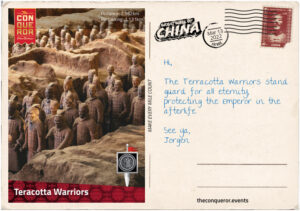Vårt nästa vykort kom denna söndag!

Tjugotredje vykortet
The amazing discovery of the world-renowned Terracotta Warriors was the accidental work of a small group of farmers digging a well. Imagine their surprise when, instead of finding water, they dug up a head made of terracotta.
It was 1974 and the archaeologists were in for a treat. The more they peeled back the covers, the more they needed to keep going. Hundreds upon hundreds of soldiers, horses, chariots, armour and weaponry were being revealed.
Four main pits were unearthed, with Pit 1 being the largest. At 750ft (230m) long and 203ft (62m) wide, the pit contains 6,000 warriors, 200 horses and 50 chariots. The warriors are life-sized, between 5.74-6.6ft (175-200cm) tall and weigh several hundred pounds each. Pit 2, although smaller, has 850 warriors, 116 cavalry and 89 chariots each drawn by four horses. Although debated, it is thought that these two pits may represent the imperial palace guards. Pit 3 is the smallest, containing a single chariot drawn by four horses and 68 warriors. This one is thought to be the command centre. Pit 4 is empty, perhaps an unfinished project.
Sculpted from terracotta, each figure was moulded by artisans into separate body parts and then assembled into a complete statue. Wet clay was then applied to create individual details. Standing according to rank, they feature different uniforms, distinct hairstyles, individual facial features, even their ears are unique.
All the figures were once fabulously painted in striking colours of red, pink, green, blue, black and white but unfortunately their exposure to air caused the colour to dry and flake. Fortunately, new techniques have been developed to successfully preserve the colours on new excavations.
The creation of the Terracotta Army was ordered by the First Emperor of the Qin Dynasty, Qin Shi Huang (3rd century BC). Supposedly a workforce of more than 700,000 people was used to construct enormous tombs filled with treasures and an army to protect him in the afterlife.
His massive mausoleum, less than a mile (1.5km) away from the pits, remains sealed. There are concerns that an excavation may damage the emperor’s corpse and artifacts in the tomb, a greater concern are the rivers of liquid mercury that have been detected inside the tomb. The emperor was obsessed with immortality and believed that mercury was the elixir of life. In his quest for eternal life, he ingested mercury pills regularly. Instead of making him live forever, it most likely contributed to his death.